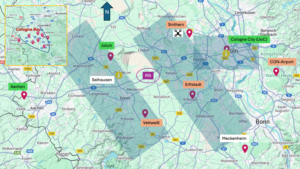VITAL: Vertical profiling of the troposphere: Innovation, opTimization and AppLication
The VITAL (Vertical profiling of the troposphere: Innovation, opTimization and AppLication) concept is part of the Hans Ertel Centre for Weather Research (HErZ) and focuses on novel observations of the vertical structure of the troposphere. It is a common, networking effort of four HErZ projects, DWD observational and modeling experts as well as different external partners. The concept consists of two measurement campaigns: VITAL I and VITAL II.
VITAL I took place in August 2024 at the Jülich Observatory for Cloud Evolution (JOYCE). It generated vertical profiling data sets in the ABL to assess instruments and methods for the next-generation DWD observational network, including Uncrewed Aerial Systems (UAS), water vapor lidar and microwave radiometer. The observations were compared against satellite data, Doppler lidar, radiosondes and data from a 120m meteorological tower. VITAL I also participated in the core phase of the 2024 world-wide WMO UAS Demonstration campaign with two small UAS applying a novel, improved wind and turbulence estimation technique. During VITAL I, an international summer school was held at JOYCE to educate students from the Bachelor to PhD level in Modern Methods in Atmospheric Profiling.
VITAL II is planned for 2026 and will take place from June 1 – August 31 in the Cologne Bay region between the west German cities of Cologne, Bonn and Aachen employing and installing up to seven profiling sites. During this time, first data from the Meteosat Third Generation Sounder (MTG-S1) satellite will become available providing continuous 3D observations of temperature and humidity over large parts of Europe and Africa with a temporal resolution of ~30 min. However, deficits will remain in observing the atmospheric boundary layer (ABL). VITAL II will leverage the use of these novel satellite sounder observations by combining them with surface-based in-situ and remote sensing observations. Novel machine learning algorithms which will synthesize MTG-S1 data with surface-based observations will be applied to and assessed by the multitude of additional VITAL II profiling observations. The objective is to significantly enhance the observed information content in the ABL.
 VITAL II observational setup concentrated in the Cologne Bay (CB, see inset figure, upper left). Red markers indicate VITAL II ground-based remote sensing profiling sites for wind, turbulence, temperature and humidity. All profiling sites are equipped with near-surface meteorology measurements (including radiation). Profiling sites with green background are existing, with a peach background are planned for VITAL II. ~100 Radiosondes will be launched on demand in the CB area. UAS Multicopter profiling sites are planned in Sinthern during the IOP between July and August 2026. Additional ~50 near-surface measurements of temperature, pressure and humidity will be available from the autonomous cold pool logger 2 (APOLLO 2.0) network to be set up in the gray-shaded areas. The purple oval indicates an MTG-S1 IRS pixel size. IRS coverage is available over the whole domain. Source of the map: Google Maps
VITAL II observational setup concentrated in the Cologne Bay (CB, see inset figure, upper left). Red markers indicate VITAL II ground-based remote sensing profiling sites for wind, turbulence, temperature and humidity. All profiling sites are equipped with near-surface meteorology measurements (including radiation). Profiling sites with green background are existing, with a peach background are planned for VITAL II. ~100 Radiosondes will be launched on demand in the CB area. UAS Multicopter profiling sites are planned in Sinthern during the IOP between July and August 2026. Additional ~50 near-surface measurements of temperature, pressure and humidity will be available from the autonomous cold pool logger 2 (APOLLO 2.0) network to be set up in the gray-shaded areas. The purple oval indicates an MTG-S1 IRS pixel size. IRS coverage is available over the whole domain. Source of the map: Google Maps
VITAL II also extends upon the success of the FESSTVaL, a 2021 field experiment which focused on the meso-g-scale (2–20km) providing a high-density surface observation network paired with continuous, ground-based atmospheric profiling at three distinct locations within 6 km of each other. VITAL II will extend profiling and dense near-surface observations to the meso-b-scale (20–200km = regional scale). Up to 50 surface stations of the updated autonomous cold pool logger 2 (APOLLO 2.0) will be installed within Cologne Bay. The planned observational setup, in synergy with the MTG-S1 measurements, will provide important elements in enhancing our understanding of the evolution of the stable and convective ABL as well as convective cold pools. The observations will be used for assessing and improving the German Meteorological Service (DWD) Numerical Weather Prediction (NWP) model ICON land surface and ABL parameterization schemes. In addition, data assimilation experiments with the novel data are planned.
A current version of the VITAL II concept paper can be found here: 10.5281/zenodo.17424651
For questions to the campaign, e.g. concerning scientific background, participation, data availability etc. please contact ulrich.loehnert@uni-koeln.de
